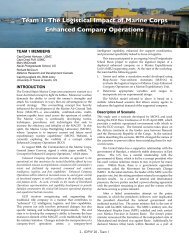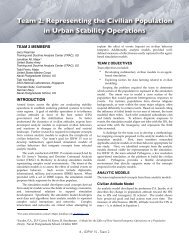pdf file - SEED Center for Data Farming - Naval Postgraduate School
pdf file - SEED Center for Data Farming - Naval Postgraduate School
pdf file - SEED Center for Data Farming - Naval Postgraduate School
You also want an ePaper? Increase the reach of your titles
YUMPU automatically turns print PDFs into web optimized ePapers that Google loves.
Throughput<br />
The throughput process models the physical movement of<br />
equipment from the pier to the using unit and any<br />
maintenance or setup actions that must be completed to<br />
make equipment operational. The equipment is classified by<br />
type with each type requiring various assets during<br />
throughput as identified in Table 1.<br />
Throughput<br />
Equipment Type<br />
Assets AMMO ISO RS MTVR HET<br />
Throughput Driver X X<br />
Mechanic X X X<br />
RTCH, Pier X X<br />
RTCH, CSA X X<br />
Armor Teams<br />
X<br />
Truck<br />
X<br />
Truck Convoy X X<br />
Driver Convoy X X<br />
HET Convoy<br />
X<br />
Security Convoy X X X X X<br />
Table 1: Throughput Asset and Equipment Dependencies<br />
The equipment must undergo various sub-processes<br />
dependent upon equipment type and additional factors such<br />
as a piece of equipment being 'frustrated' (dead lined and<br />
requiring maintenance) at the time of offload. The<br />
dependencies between throughput assets and sub-processes<br />
are identified in Table 2.<br />
Model Parameters<br />
Each of the offload and throughput resources is a<br />
parameter that can be controlled in the model. Additional<br />
parameters are:<br />
1. Ship Crane Delay - time required to offload a piece<br />
of equipment using a ship crane.<br />
2. Gantry Crane Delay - time required to offload a<br />
piece of equipment using a gantry crane.<br />
3. Ramp Delay - time required to offload a piece of<br />
equipment using a ramp.<br />
4. Return Offload Driver Delay - time required <strong>for</strong> an<br />
offload driver to return to<br />
the ship and be available<br />
to offload another vehicle.<br />
Throughput<br />
5. Rough Terrain Container<br />
Assets<br />
Handler (RTCH) Delay -<br />
time required to load/<br />
unload a container on a Throughput Driver<br />
truck.<br />
6. Truck Speed - speed at<br />
which a truck <strong>for</strong> moving<br />
ISO containers moves<br />
within the port.<br />
7. Pier to Container Storage<br />
Area (CSA) Distance<br />
8. Frustrated Delay - time<br />
required <strong>for</strong> a mechanic to<br />
repair a frustrated piece<br />
of equipment.<br />
Frustrated<br />
35 - IDFW 20 - Team 9<br />
9. Frustrated Rate - probability that equipment is<br />
frustrated at offload.<br />
10. SL3 Delay - time required to set up SL3 equipment<br />
on vehicles.<br />
11. Mechanic Priority - the relative priority of SL3 vs.<br />
frustrated equipment <strong>for</strong> mechanics.<br />
12. MTVR Armoring Resources - the number of<br />
resources dedicated to armoring MTVRs.<br />
13. Rolling Stock (RS) to Movement Control <strong>Center</strong><br />
(MCC) Delay - time required to move RS vehicles<br />
from the pier to the MCC staging area where they<br />
are <strong>for</strong>med into convoy sticks by destination.<br />
14. Port to Destination Distance - distance from the<br />
port to the final destination. Each destination is an<br />
independent variable.<br />
15. Convoy Delay at Destination<br />
16. Convoy Priority - priority <strong>for</strong> assigning security<br />
assets to convoys.<br />
Scenario<br />
In this scenario, we model a single MPSRON offload. The<br />
MPSRON has 4,298 Principle Equipment Items (PEIs)<br />
spread across four ships with the following breakdown by<br />
equipment type:<br />
• ISO (General Cargo Containers)! 42%<br />
• RS (Rolling Stock Vehciles)! 32%<br />
• AMMO (Ammo Containers)! 14%<br />
• MTVR (Sub-set of Rolling Stock)! 7%<br />
• HET (Tracked Vehicles)! 5%<br />
Metrics<br />
Figure 2 is a screen shot of the model outputs. The blue,<br />
green and red lines represent the counts of equipment over<br />
time at the pier, at the final destination, and in the<br />
throughput process respectively. We use days to complete<br />
offload, the days to complete throughput and the mean cycle<br />
time of equipment (time complete - time offloaded) as our<br />
primary metrics.<br />
SL3<br />
Setup<br />
Throughput Sub-Processes<br />
Move ISO Pier<br />
to CSA<br />
Move RS<br />
Pier to MCC<br />
Armor<br />
MTVRs<br />
Convoy To<br />
Using Unit<br />
X<br />
Mechanic X X<br />
RTCH Pier X X (Ammo)<br />
RTCH CSA X X (ISO)<br />
Armor Teams<br />
Truck<br />
Truck Convoy<br />
Driver Convoy<br />
HET Convoy<br />
Security Convoy<br />
X<br />
Table 2: Throughput Assets and Sub-Process Dependencies<br />
X<br />
X<br />
X<br />
X<br />
X




